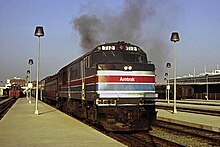Peninsula Commute
[1] By the end of 1868, it was revealed the Big Four of the Central Pacific consisting of Stanford, Huntington, Hopkins, and Crocker had a controlling interest in the SF&SJ and SP, and the SF&SJ, SP, the Santa Clara and Pajaro Valley Railroad, and the California Southern were folded into a consolidated Southern Pacific Railroad on October 12, 1870.
[3] The first of these, the Bayshore Cutoff, opened in 1907 and rerouted the line through a series of five tunnels built along the shoreline of the San Francisco Bay Area.
This saved approximately three miles and seventeen minutes compared to the prior route,[4] which veered to the west around San Bruno Mountain.
[8] Just a few days later, SP cited excessive post-war inflation, taxation, and competition from publicly funded highways as factors making electrification neither "practicable or desirable".
As Southern Pacific's franchise to operate on 4th Street in San Jose was ending, it elected to build a diversion track to the west.
This line forced a move for the city's passenger traffic to a new station at Cahill, placing it one mile from downtown (whereas it had previously been a four-block distance).
[16] The sole daily commute train which utilized the Mayfield Cutoff between Palo Alto and Vasona was discontinued in 1964 with the construction of the Foothill Expressway.
[29] In 1971, when Amtrak took over long distance passenger operations, Southern Pacific's extended commute train to Monterey, the "Del Monte", was discontinued.
Some SP passenger locomotives were sold to Amtrak and the remainder were transferred to Peninsula Commute service, which continued to operate.
In 1975, the Metropolitan Transportation Commission (MTC) published the Feasibility of Upgrading Peninsula Passenger Rail Service (PERSUS) report.
[20] Because the CPUC decision process was so slow, SP President Benjamin Biaggini offered to purchase 1,000 eight-passenger vans and donate them for vanpools in exchange for permanently discontinuing the Peninsula Commute service.
Ironically, it is so bad it is likely to even jeopardize the interest of the one group who seems to benefit, that is the present SP commuters who are being so heavily subsidized by others.
From our involvement in the case we have seen nothing that could be used to prove that the ICC is wrong in taking this unfortunate action.On May 6, 1977, SP formally filed a petition with the CPUC (Application No.
[40] On October 17, 1977, the administrative law judge issued an order asking "Who will pay the cost of this regional insurance against the uncertainties of tomorrow?
[3] In response to the CPUC petition, Assemblymember Lou Papan wrote Assembly Bill 1853, which allowed local transit districts served by the Peninsula Commute to purchase tickets from SP at face value and sell them to riders at a discount, subsidizing passengers.
[42] AB 1853 also allowed the California Department of Transportation (Caltrans) to negotiate with SP for operation of the commuter rail service and the purchase of the right-of-way between Daly City and San Bruno, which had only seen occasional freight traffic since the completion of the Bayshore Cutoff in 1907.
The recommendations of the 1977 Peninsula Transit Alternatives Project (PENTAP) Report (mandated by the Legislature in 1975 by SB 283)[43] were used to draft AB 1853.
411 in 1977, proposing a three-phased approach:[40] In a December 1977 public hearing before the Assembly Committee on Transportation held in San Jose, SP executive Alan DeMoss testified that "rail commute service should no longer be cross-subsidized by other railroad activities"[20] and offered $8 million to help purchase buses to replace the service.
[44] However, both samTrans and the Santa Clara County Transit District stated they would not be able to operate that bus service; it was estimated that a fleet of 122 buses would be required, arriving and departing from San Francisco every 35 to 50 seconds.
However, ridership continued to decline and the farebox recovery ratio fell to 34.3% in the 1983–84 fiscal year,[49] which violated the minimum of 40% set by AB 1010 in 1982.
SP took over the Peninsula Corridor route from the SF&SJ in 1870 and assumed control of the existing set of locomotives and passenger cars, which were mainly 4-4-0 steam engines and 36-passenger wooden railcars.
[54] By the early 1950s, peak-hour trains were pulling up to seventeen cars in a single consist, requiring the use of the "General Service" class 4-8-4s.
[54] SP began testing Fairbanks-Morse (F-M) "Train Master" H-24-66 locomotives in late 1953, and purchased two of the four demonstrator models for use on the Peninsula Commute service.
The Train Masters, which used the unique opposed-piston two-stroke 38 8-1/8 prime mover developed by F-M for American diesel-electric submarines in World War II, were the most powerful diesel-electric locomotives available at a nominal 2,400 hp (1,800 kW), and had performance comparable to the 4-8-4s for peak service: while the starting tractive effort of the "General Service" class 4-8-4 ranged from 63,230 to 66,330 lbf (281.3 to 295.1 kN),[58] the Train Master was rated at 79,500 lbf (354 kN).
Peninsula residents clamored for lower fares as early as 1908; SP officials replied by pointing out rates were already cheaper than similar services in New York, Boston, Philadelphia, Chicago, and Baltimore.
[97] Also in 1912, SP proposed that private club cars be provided on several morning trains to allow commuters to "enjoy a shave or shampoo and indulge in convival highball while making their daily trips to San Francisco.






